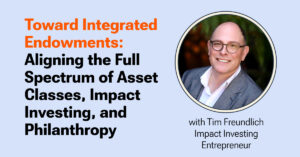Donor acquisition is a major priority for every nonprofit. Alongside stewarding your current donors, you need to consistently secure new donors for your Donor acquisition is a major priority for every nonprofit. Stewardship and acquisition are both essential for fundraising sustainably and setting your nonprofit up for growth.
So what do you do when your donor acquisition rates are struggling? The first step is finding out why. In this guide, we’ll explore common reasons nonprofits experience stagnant or declining donor acquisition rates and what you can do to improve them.
As we break down these common roadblocks to success, consider whether they apply to your current strategy. Then, use our tips to develop a donor acquisition strategy that helps you identify prospective donors and secure their lasting support.
1. You’re only using one channel for marketing.
To acquire new donors, you have to post content where prospective donors are! If you only use one or two marketing channels, you’ll only access a limited number of new donors.
Luckily, this problem is easy to solve. First, analyze your current marketing content’s performance. Then, select multiple channels to branch out to based on the benefits they offer, such as:
- Direct mail: Many nonprofits only use digital marketing channels, causing them to miss out on direct mail’s benefits. However, this channel is more effective for acquisition than you might think. Direct mail is tangible and personal, helping your messages stand out in a small bundle of mail rather than in an overflowing inbox.
- Your website: Your nonprofit’s website is your online fundraising hub and a crucial marketing channel. Assess your landing pages, visuals, and blog to make sure the content aligns with your new multichannel strategy.
- Email: When used alongside other communication channels, email becomes an even more effective avenue for sourcing new donors. For example, when a new supporter signs up for your mailing list on your website, you can amplify your impact by sending an immediate welcome email and following that message with a welcome packet sent via direct mail.
- Social media: Due to high competition for attention and algorithms that aren’t always friendly to nonprofits, social media has mixed effectiveness for donor acquisition. Combined with other channels, however, social media content can increase brand awareness and bring new supporters to your website, email signup, and events.
The more touchpoints you have with prospective donors, the more likely they are to remember your organization. No matter which platforms you choose, include clear calls to action and next steps by linking to landing pages that will drive conversions.
2. You’re not targeting your audience effectively.
If you’re already on the platforms your target audience uses but still experiencing low donor acquisition rates, ask yourself if you’re just posting on those platforms or actively targeting your audience.
NPOInfo’s donor data management guide suggests using your donor engagement data to identify key characteristics of your current audience, then target similar prospects. Specifically, take insights from these metrics:
- Per-channel engagement levels: First, look at per-channel open rates and engagement data to determine which channels your supporters engage with most. Then take a look at the types of content that receive the most likes, shares, views, and comments to learn more about your audience’s preferences.
- Per-channel conversion rates: Is your content actually recruiting new supporters, or are they just interacting with it? Determine which outreach methods and marketing content actually lead to donations and event attendance.
- Average giving amount and frequency: While less obvious, your existing donors’ giving data can help you create tailored outreach and better fundraising asks. For example, if the majority of your nonprofit’s current donors give under $200, you shouldn’t suggest donation amounts of $1,000 to similar prospects.
Record this information in your donor database and frequently reevaluate it to stay on top of new developments and adjust your outreach approach.
3. Your content isn’t compelling.
Your content might reach the right supporters on the right channels, but still fail to convert if it isn’t persuasive enough. After all, there are thousands of nonprofits out there with worthy missions. Your content should explain why your organization uniquely deserves support.
A common critical mistake is undervaluing the importance of storytelling. Dry, information-only outreach won’t capture prospects’ attention or spark a genuine interest in your nonprofit, but effective storytelling will.
In each piece of content you create to attract new donors, convey the story of your nonprofit and the important work you do. Why does your community need your nonprofit? Whose lives are impacted by donations, and how? Tell the stories of beneficiaries, longtime supporters, and your staff, using firsthand testimonials when possible. Infuse these stories into your outreach to make an emotional connection with each reader.
Storytelling is key for all of your outreach and marketing content, especially your website’s landing pages. People interested in supporting your nonprofit will visit your website to learn more, so you need to make a positive first impression by including authentic, compelling stories.
4. You lack a clear strategy.
All the points we’ve covered so far boil down to this: Without a clear donor acquisition strategy, your outreach can easily fall flat. To stay on top of your communications, leverage these tips to create an updated, comprehensive acquisition strategy.
Compile your data, resources, and budget, then create a detailed acquisition plan by following these steps:
- Set outreach goals. While your main goal is to acquire new donors, try setting smaller goals, too. These could include increasing direct mail conversions, successfully expanding to a new channel, or acquiring a certain number of major donors.
- Determine a clear action plan. Outline the channels you’ll use, how often you’ll post, and how you’ll reach out to different prospect segments. Schedule times to check in with your staff and update your strategy as needed.
- Reevaluate your data. To increase your donor acquisition rates and keep them from dropping, continuously reevaluate your data and adjust your approach accordingly.
If you need help crafting a new strategy, consider working with a nonprofit marketing consultant. Meyer Partners’ list of top nonprofit consultants discusses how these professionals can provide a fresh set of eyes to your existing strategies and share insights based on their experience working with hundreds of other nonprofits.
To find a consultant that fits your nonprofit, browse recommendation lists and reach out to other nonprofits about their experiences with consultants. Then, research each consultant’s services to identify what type of work they do and what kinds of nonprofits they usually work with. From there, create a short list of top candidates and start reaching out to introduce your nonprofit and discuss your marketing needs.
5. Your nonprofit is hard to engage with.
Sometimes, would-be donors connect with your content, visit your website, reach your donation page, and still fail to convert. When prospective supporters stumble right at the finish line, assess whether donating to your nonprofit is actually easy.
A few signs you may need to improve your donation process include:
- Poor calls to action. Your fundraising appeals and outreach messages should always end with directions for what supporters should do next. If your nonprofit isn’t already issuing calls to action, start brainstorming compelling language and clear next steps you can add to your content. Additionally, each message should only have a single call to action to focus supporters’ attention on a specific goal.
- Unintuitive website design. When new visitors reach your website, is it easy for them to find information about your nonprofit and locate key pages like your donation form? Analyze your website metrics, like your traffic and bounce rate, to see what pages supporters are visiting and track the typical user journey. With this data, you can see where in the donation process supporters stall out, helping you identify potential user experience issues, such as unintuitive menus, confusing page layouts, or broken links.
- Long donation pages. While gathering as much information about your supporters as possible is useful for donor stewardship, stick to the basics during acquisition. Incentivize giving by keeping your donation form short and to the point, asking only for essential contact and payment information.
Given your own familiarity with your nonprofit’s content, website, and donation page, you may need an outside perspective to assess its user-friendliness. Again, this is where a fundraising consultant can help out by bringing an external viewpoint as they navigate your acquisition process for the first time.
Once you establish a better approach to donor acquisition using these strategies, work on cultivating relationships. After all, you need to keep those new donors engaged to ensure they stay invested in your mission for the long haul.
Alyssa Jefferies

Alyssa Jefferies, MNA, CFRE brings to her role as President of Meyer Partners nearly 20 years of fundraising experience, with a special emphasis on direct response fundraising, stewardship, and mid-level giving. Along with helping nonprofits across the country reach their fundraising and marketing goals, Alyssa serves on the board of the Association of Direct Response Fundraising Counsel (ADRFCO) of The Nonprofit Alliance.
This blog is an original work of the attributed author. It is shared with permission via Foundant Technologies’ website for informative purposes only as part of our educational content in the social good sector. This text’s views, thoughts, and opinions belong solely to the author and do not necessarily reflect Foundant’s stance on this topic.

